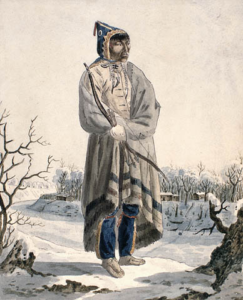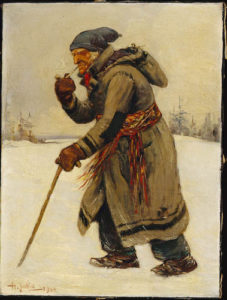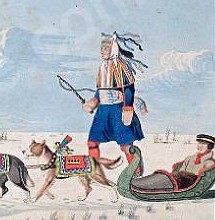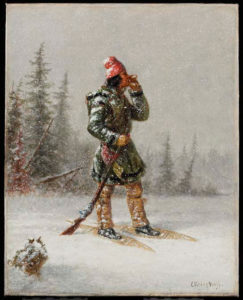
“Saulteaux standing in a winter landscape.” Peter Rindisbacher, 1822 (Library and Archives Canada)
We’re hardy modern voyageurs. We know that keeping our hands warm and dry when working outside during winter is important, very important. But how best to protect those digits when you’re reenacting the “little ice age” winters of the late 18th and early 19th centuries?
Sticking your fingers in armpits or crotch works, but leaves you helpless when struggling to get fires lit in a big hurry or snowshoes buckled or unbuckled in a big hurry. You need something that warms, insulates and keeps fingers functional. Obviously, hand coverings are needed, but what is not only effective but historically accurate?
Mittens. Yep, mittens . . . even hung from strings around your neck! Period appropriate, historically accurate, documented from fur trade sources, as well as effective, easy to make.
Mittens are basically bags that covers the hand and fingers, sometimes with a separate but attached bag that covers the thumb. Plain and simple, they work.

“L’etoffe du pays,” Henri Julien, (Musée des beaux-arts du Quebec)
While fur trade ledgers and trade manifests rarely mention mittens, there is ample documentation that mittens were not only used in the Northwest, they were produced by those that used them . . .
…people making Socks, Mittens, Capotes, etc. for Winter clothing as the cold is severe and the Snow about mid Leg deep. —David Thompson, 1808
They [Natives] makes mittens of skins or flannel . . . which serves them better than gloves, because the separated fingers would be more liable to freeze. —Pierre Pouchot, 1755-1760
English terms include mitons, mitts and muffatees. French-Canadians used the terms moufle and mitaines. Unfortunately, true definitions of these terms are difficult since various sources use these terms interchangeably. Even Samuel Johnson’s 1755 Dictionary of the English Language defines “mittens” as “coarse gloves for winter.”

Detail “A Dog Cariole Only Used in Winter,” Peter Rindisbacher, 1820s.
…became so cold that the Indians were obliged to make use of their mittens. —Alexander Mackenzie, June 1789
In winter…we cover our hands with a kind of muffs called here mittens. —Pierre Boucher, New France, 1694
…our hands are in our large mittens…Gloves are found to be worse than useless. —David Thompson, Hudson’s Bay, 1784-1788
And those strings? Simplicity works. Costume historian Jane Paterek, author of the Encyclopedia of American Indian Costume, describes the string as being “…in Eskimo fashion.” This makes a case for Native Americans being the originators of this idea . . .
…mittens …made of moose or deerskin…large and fastened to a string which is thrown over the neck. —Andrew Graham, 1767-91
…their mittens are also suspended from the neck in a position convenient for the reception of the hands… —Alexander Mackenzie, 1789
…their hands are protected by mittens suspended by thongs from the neck… —George Heriot, 1807
Even after years of technological advances the basic mitten remains the warmest on the hand. The reason for the warmth in mittens over gloves is two-fold. Friction created by the fingers touching one another produces heat, and in mittens more air is trapped, which helps to insulate your hands from the outside cold.
Common sense and research show simple mittens are not only the most practical hand protection but Period appropriate, historically accurate. Mittens of leather with optional wool blanket liners may be the key to successful warm hands for modern Nor’Westers. At the least, wool blanket mittens, which are easy to make can be worn. No matter what your choice, choose, and be warm and safe during the season of cold.
In warm days we use only large leather mittens lined with duffel or blanketing, and fastened together with a string like the natives. But in sharp weather, beaver mittens with the fur outwards, for defending the face on occasions; these are lined and fastened like the others. —Andrew Graham, 1767-1791

“Calling the Moose,” Cornelius Krieghoff, ca 1860. (Art Gallery of Ontario)
Please note that this is not original research, but a compilation of a lot of material from various sources. It’s as accurate as I can make it. Still, as with any historical research, take all this with a “grain of salt.” Your mileage may vary. Thanks to Karl Koster for his many postings to the h-voyageur (http://groups.yahoo.com/group/h-voyageur/) and now defunct 18cWoman Yahoo groups and, most especially, for sharing his article, “Obliged to make use of their mittens…”

